
Belgian postcard, no. 1. Publicity postcard by The Three Caballeros (Norman Ferguson, Clyde Geronimi, Jack Kinney, Bill Roberts, 1944). Caption: We are the Three Caballeros.
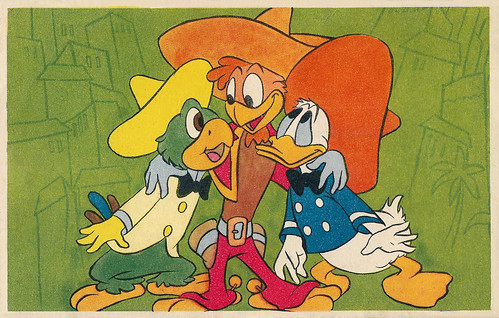
Belgian postcard, no. 2. Publicity postcard by The Three Caballeros (Norman Ferguson, Clyde Geronimi, Jack Kinney, Bill Roberts, 1944). Caption: Panchito recounts his exploits to Joe Carioca and Donald Duck.
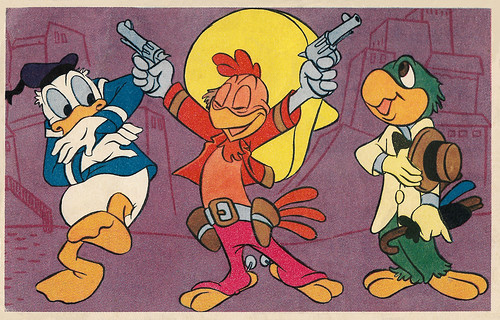
Belgian postcard, no. 3. Publicity postcard by The Three Caballeros (Norman Ferguson, Clyde Geronimi, Jack Kinney, Bill Roberts, 1944). Caption: And the party begins, Panchito gives the signal.

Belgian postcard, no. 4. Publicity postcard by The Three Caballeros (Norman Ferguson, Clyde Geronimi, Jack Kinney, Bill Roberts, 1944). Caption: Panchito, Donald, and Joe Carioca visit the city on their flying carpet.
The second of the Disney package films of the 1940s
The Three Caballeros plots an adventure through parts of Latin America, combining live-action and animation. It is the second of the Disney package films of the 1940s.
The film is a series of self-contained segments, strung together by the device of Donald Duck opening birthday gifts from his Latin American friends.
Several Latin American stars of the period appear, including singers Aurora Miranda (sister of Carmen Miranda) and Dora Luz, and dancer Carmen Molina.
Throughout the film, the Aracuan Bird appears at random moments. He usually pesters everyone, sometimes stealing José's cigar. His most famous gag is when he re-routes the train by drawing new tracks. He later returns in Melody Time (Clyde Geronimi, Wilfred Jackson, Jack Kinney, Hamilton Luske, 1948).
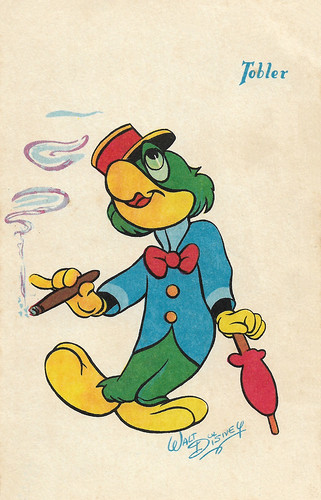
French postcard by Imp. Georges Lang, Paris, offered by Chocolats Tobler. Image: Walt Disney.
José Carioca is an anthropomorphic Brazilian parrot that first appeared in Disney's animated feature film Saludos Amigos (1943). A slick and debonair malandro from Rio de Janeiro, José met and befriended Donald Duck during the latter’s trip to South America. In later years, José joined Donald and the rambunctious rooster Panchito Pistoles as a member of the Three Caballeros (1944). José is based on a parrot spotted by Walt Disney during his Brazilian trip.

French postcard by Imp. Georges Lang, Paris, offered by Chocolats Tobler. Image: Walt Disney.
Mexican rooster Panchito Pistoles first appeared in Disney's The Three Caballeros (Norman Ferguson, a.o., 1945). Panchito lives in Mexico and rides on a horse called Señor Martinez. He is a bombastic, trigger-happy caballero that becomes instant friends with Donald Duck and José Carioca. Panchito is extremely boisterous, fast-talking, and fun-loving. He can be described as a party animal, with a love for fiestas, dancing, and women. Panchito’s kinetic energy often leads to over-the-top shenanigans for himself and his friends.

Belgian postcard, no. 5. Publicity postcard by The Three Caballeros (Norman Ferguson, Clyde Geronimi, Jack Kinney, Bill Roberts, 1944). Caption: Joe Carioca asks what this bewitching music is.
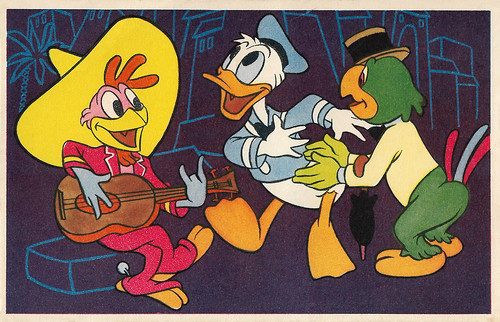
Belgian postcard, no. 6. Publicity postcard by The Three Caballeros (Norman Ferguson, Clyde Geronimi, Jack Kinney, Bill Roberts, 1944). Caption: Gained by the hectic rhythm, Donald Duck sings with his beautiful voice.
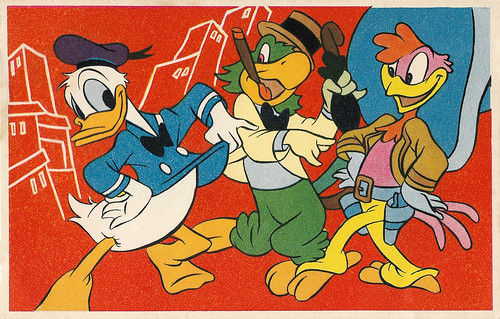
Belgian postcard, no. 8. Publicity postcard by The Three Caballeros (Norman Ferguson, Clyde Geronimi, Jack Kinney, Bill Roberts, 1944). Caption: Panchito introduces Donald Duck and Joe Carioca to the samba step.
Technological razzle-dazzle
The Three Caballeros was produced as part of the studio's goodwill message for South America but is less obviously propagandistic than many of its wartime productions.
The film again stars Donald Duck, who in the course of the film is joined by an old friend, José Carioca, the cigar-smoking parrot from Saludos Amigos, representing Brazil, and later makes a new friend in the persona of a pistol-packing rooster Panchito Pistoles, representing Mexico.
The Three Caballeros received mixed reviews upon its original release. Most critics were relatively perplexed by the "technological razzle-dazzle" of the film, thinking that, in contrast to the previous feature films up to this time, "it displayed more flash than substance, more technique than artistry."
Bosley Crowther wrote in The New York Times: "Dizzy Disney and his playmates have let their technical talents run wild."
Today, critics are more positive. Stephen Thomas Erlewine at AllMovie: "Filled with achingly funny jokes, good music, and stunning, ground-breaking animation, The Three Caballeros remains extremely entertaining decades after its release. It is one of Disney's unacknowledged classics."
Calstanhope at IMDb: "The animation is very good and some of the music (especially the title song) is memorable. Watch it for what it is and enjoy!"

Belgian postcard, no. 9. Publicity postcard by The Three Caballeros (Norman Ferguson, Clyde Geronimi, Jack Kinney, Bill Roberts, 1944). Caption: Donald Duck and Carioca dance the Samba.

Belgian postcard, no. 10. Publicity postcard by The Three Caballeros (Norman Ferguson, Clyde Geronimi, Jack Kinney, Bill Roberts, 1944). Caption: Driven by the rhythm, Donald Duck and Joe Carioca dance frenetically.

Belgian postcard, no. 11. Publicity postcard by The Three Caballeros (Norman Ferguson, Clyde Geronimi, Jack Kinney, Bill Roberts, 1944). Caption: The dynamism of Joe Carioca amazes Panchito and Donald Duck.

Belgian postcard, no. 12. Publicity postcard by The Three Caballeros (Norman Ferguson, Clyde Geronimi, Jack Kinney, Bill Roberts, 1944). Caption: The three friends, all sad, leave Baïa.
Sources: Stephen Thomas Erlewine (AllMovie), Disney Wiki, Wikipedia, and IMDb.
No comments:
Post a Comment